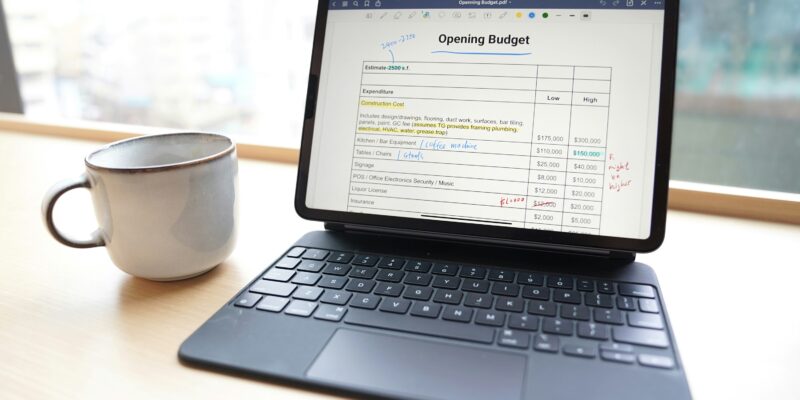
Budgeting is one of the most powerful tools for taking control of your finances, yet many people find it intimidating or difficult to stick to. The key to a successful budget isn’t rigidity but flexibility—a plan tailored to your needs, goals, and lifestyle. When done right, a budget empowers you to spend intentionally, save for the future, and reduce financial stress.
In this guide, we’ll walk you through creating a budget that works for you and provides actionable steps to help you stick to it.
Step 1: Understand Your Income and Expenses
Before you create a budget, you need a clear picture of your current financial situation.
Track Your Income
- List all sources of income: salary, freelance work, investments, or side hustles.
- Use your net income (after taxes) for a realistic view of what you have available.
Track Your Expenses
- Review your bank and credit card statements from the last three months.
- Categorize your expenses into fixed (e.g., rent, insurance) and variable (e.g., dining out, entertainment).
- Identify irregular expenses like annual subscriptions or holiday gifts.
Tip: Use budgeting tools like Mint, YNAB (You Need a Budget), or a simple spreadsheet to organize this information.
Step 2: Set Clear Financial Goals
Your budget should reflect what you want to achieve with your money. Define short-term, medium-term, and long-term goals.
- Short-term (0-1 year): Build an emergency fund, pay off credit card debt, or save for a vacation.
- Medium-term (1-5 years): Save for a car, a wedding, or further education.
- Long-term (5+ years): Plan for retirement or invest in property.
Tip: Use the SMART framework (Specific, Measurable, Achievable, Relevant, Time-bound) to set actionable goals.
Step 3: Choose a Budgeting Method
There are various budgeting methods, and the right one depends on your preferences and financial goals.
1. 50/30/20 Rule
- 50% Needs: Essentials like housing, utilities, groceries, and transportation.
- 30% Wants: Non-essential spending like dining out, hobbies, and entertainment.
- 20% Savings/Debt Repayment: Emergency fund, retirement, or paying off loans.
2. Zero-Based Budgeting
- Assign every dollar a purpose until your income minus expenses equals zero.
- Ideal for those who prefer detailed tracking and control.
3. Envelope System
- Allocate cash for each spending category in physical envelopes.
- Once the cash is gone, you’re done spending in that category.
- Works well for curbing overspending.
Tip: Experiment with different methods to see what suits your lifestyle.
Step 4: Build Your Budget
Using your income and expense data, allocate your money to each category.
Example Budget:
| Category | Percentage | Amount (Income: $3,000/month) |
|---|---|---|
| Needs | 50% | $1,500 |
| Wants | 30% | $900 |
| Savings/Debt Repayment | 20% | $600 |
Adjust Based on Priorities:
- If paying off debt is a priority, allocate more to debt repayment.
- For savings goals, consider cutting back on non-essential spending.
Step 5: Automate and Monitor Your Budget
Automate Your Finances
- Set up automatic transfers to savings accounts.
- Automate bill payments to avoid late fees.
Track Progress
- Review your spending weekly or monthly.
- Use apps like PocketGuard or YNAB to track expenses in real time.
Tip: Regularly adjust your budget based on changes in income, expenses, or goals.
Step 6: Build an Emergency Fund
An emergency fund is a financial safety net for unexpected expenses, such as medical bills or car repairs. Aim to save 3-6 months’ worth of living expenses.
Start Small:
- Save a portion of each paycheck, even if it’s $50 or $100.
- Automate contributions to a high-yield savings account.
Step 7: Stay Flexible and Realistic
Life is unpredictable, and your budget should adapt to changes. Revisit and revise your budget regularly to ensure it aligns with your goals and circumstances.
Avoid Budget Burnout:
- Allow room for occasional indulgences.
- Don’t be discouraged by setbacks; focus on consistency.
Common Budgeting Mistakes to Avoid
- Underestimating Expenses: Be realistic about your spending habits.
- Not Accounting for Irregular Costs: Plan for occasional big-ticket items.
- Skipping Emergency Savings: Make building a safety net a top priority.
- Being Too Restrictive: A rigid budget is harder to stick to.
- Failing to Review Progress: Regular check-ins help you stay on track.
The Benefits of a Budget That Works
- Financial Clarity: Understand where your money goes each month.
- Reduced Stress: Feel more confident and in control of your finances.
- Faster Goal Achievement: Allocate resources effectively to reach milestones.
- Improved Spending Habits: Spend intentionally rather than impulsively.
Conclusion
Creating a budget that works for you is less about restrictions and more about aligning your money with your priorities. By tracking your income and expenses, setting clear goals, and choosing a budgeting method that suits your lifestyle, you can build a plan that empowers you to achieve financial freedom.
Start small, stay consistent, and remember—a budget isn’t set in stone. It’s a dynamic tool that evolves with you and your financial journey.















